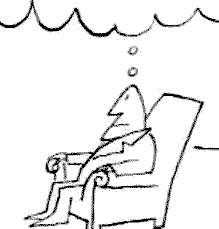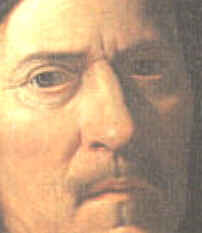1878 first attempt at motion pictures (used 12 cameras, each
taking 1 picture) done to see if all 4 of a horse's hooves leave the
ground
1877 First Black graduate of
West Point ^top^
Henry Ossian Flipper, born a
slave in Thomasville, Georgia, in 1856, becomes the first African-American
cadet to graduate from the US Military Academy at West Point,
New York. Flipper, who was never spoken to by a white cadet
during his four years at West Point, is appointed a second lieutenant
in the all-African-American 10th Cavalry, stationed at Fort
Sill in Indian Territory.
The United States Military Academy,
the first military school in America, was founded by Congress
in 1802 for the purpose of educating and training young men
in the theory and practice of military science. Located on the
high west bank of the Hudson River, West Point was the site
of a Revolutionary-era fort built to protect the Hudson River
Valley from British attack.
In 1780, Patriot General Benedict
Arnold, the commander in charge of the fort, agreed to surrender
West Point to the British in exchange for six thousand pounds.
However, the plot was uncovered before it fell into British
hands, and Arnold fled to British protection.
In 1812, the growing threat of
another war with Great Britain resulted in congressional action
to expand the US Military Academy’s facilities and increase
the West Point corps. Beginning in 1817, the academy was reorganized
by superintendent Sylvanus Thayer--later known as the "father
of West Point"--and the school became one of the nation’s finest
sources of civil engineers.
During the Mexican-American War,
West Point graduates filled the leading ranks of the victorious
US forces, and with the outbreak of the Civil War, former
West Point classmates regrettably lined up against each other
in the defense of their native states.
In 1870, the first African-American
cadet was admitted into the US Military Academy, and in 1976,
the first female cadets. The academy is now under the general
direction and supervision of the department of the US Army,
and has an enrollment of about 4300 students. |
1876 Sara Spencer (R) is first woman to address a US presidential
cconvention
1871 Phoebe Couzins is first woman graduate of a US collegiate
law school
1866 Prussia attacks Austria
1864 Robert E Lee's home area (Arlington, VA) becomes a military
cemetery
1864
Battle of Petersburg begins ^top^
During the Civil War, Ulysses
S. Grant’s Army of the Potomac and Robert E. Lee’s Army of Northern
Virginia collide for the last time when the first wave of Union
troops attack Petersburg, a vital Southern rail center thirty-seven
kilometers south of the Confederate capital of Richmond, Virginia.
The two massive armies would not become disentangled until April
9, 1865, when Lee surrendered and his men went home.
In June of 1864, in a brilliant
tactical maneuver, Grant marched his army around the Army of
Northern Virginia, crossed the James River unopposed, and advanced
his forces to Petersburg. Knowing that the fall of Petersburg
would mean the fall of Richmond, Lee raced to reinforce the
city’s defenses. The mass of Grant’s army arrived first. On
June 15, the first day of the Battle of Petersburg, some 10'000
Union troops under General William F. Smith move against the
Confederate defenders of Petersburg, made up of only a few thousand
armed old men and boys commanded by General P. G. T. Beauregard.
However, the Confederates have the advantage of formidable physical
defenses, and they hold off the overly cautious Union assault.
The next day, more Federal troops
arrived, but Beauregard is reinforced by Lee, and the Confederate
line remains unbroken during several Union attacks occurring
over the next two days. By June 18, Grant has nearly 100'000
men at his disposal at Petersburg, but the 20'000 Confederate
defenders hold on as Lee hurries the rest of his Army of Northern
Virginia into the entrenchments. Knowing that further attacks
would be futile, but satisfied to have bottled up the Army of
Northern Virginia, Grant’s army digs trenches and began a prolonged
siege of Petersburg.
Finally on April 2, 1965, with
his defense line overextended and his troops starving, Lee’s
right flank suffered a major defeat against Union cavalry under
General Phillip Sheridan, and Grant ordered a general attack
on all fronts. The Army of Northern Virginia retreated under
heavy fire, the Confederate government fled Richmond on Lee’s
recommendation, and Petersburg, and then Richmond, fell to the
Union. Less than a week later, Grant’s massive army headed off
the remnants of the Army of Northern Virginia at Appomattox
Station, and Lee was forced to surrender, effectively ending
the Civil War. |
1863 Battle of Stephenson's Depot, Virginia
1863 Siege of Port Hudson, Louisiana continues
1863 Siege on Vicksburg, Mississippi continues
1862 Gen JEB Stuart completes his "ride around McClellan"
1860 first White settlement in Idaho (Franklin)
1851 Jacob Fussell, Baltimore dairyman, sets up first ice-cream
factory
1846
US-Canadian border established, forget 54º40'
^top^
Representatives of Great Britain
and the United States sign the Oregon Treaty, which settles
a longstanding dispute with Britain over who controlled the
Oregon territory. The treaty establishes the Forty-ninth parallel
from the Rocky Mountains to the Strait of Georgia, just short
of the Pacific Ocean, as the boundary between the United States
and British Canada. The US gains formal control over the future
states of Oregon, Washington, Idaho, and Montana, and the British
retain Vancouver Island and navigation rights to part of the
Columbia River.
In 1818, a US-British agreement
had established the border along the forty-ninth parallel from
Lake of the Woods in the east to the Rocky Mountains in the
west. The two nations also agreed to a joint occupation of Oregon
territory for ten years, an arrangement that was extended for
an additional ten years in 1828. After 1838, the issue of who
possessed Oregon became increasingly controversial, especially
when mass American migration along the Oregon Trail began in
the early 1840s.
American expansionists urge seizure
of Oregon, and in 1844, Democrat James K. Polk successfully
ran for president under the platform, "Fifty-four Forty or Fight,"
which referred to his hope of bringing a sizable portion of
present-day Vancouver and Alberta into the United States. However,
neither President Polk nor the British government wanted a third
Anglo-American war, and on June 15, 1846, the Oregon Treaty
is signed.
TEXT OF THE
TREATY
ART. I. From the point of the forty-ninth parallel of
north latitude, where the boundary laid down in existing treaties
and conventions between the United States and Great Britain
terminates, the line of boundary between the territories of
the United States and those of her Britannic Majesty shall be
continued westward along the said forty-ninth parallel of north
latitude to the middle of the channel which separates the continent
from Vancouver's Island, and thence southerly through the middle
of the said channel, and of Fuca's Straits, to the Pacific Ocean:
Provided, however, That the navigation of the whole of the said
channel and straits, south of the forty-ninth parallel of north
latitude, remain free and open to both parties.
ART. II. From the point at which the forty-ninth parallel
of north latitude shall be found to intersect the great northern
branch of the Columbia River, the navigation of the said branch
shall be free and open to the Hudson's Bay Company, and to all
British subjects trading with the same, to the point where the
said branch meets the main stream of the Columbia, and thence
down the said main stream to the ocean, with free access into
and through the said river or rivers, it being understood that
all the usual portages along the line thus described shall,
in like manner, be free and open. In navigating the said river
or rivers, British subjects, with their goods and produce, shall
be treated on the same footing as citizens of the United States;
it being, however, always understood that nothing in this article
shall be construed as preventing, or intended to prevent, the
government of the United States from making any regulations
respecting the navigation of the said river or rivers not inconsistent
with the present treaty.
ART. III. In the future appropriation of the territory
south of the forty-ninth parallel of north latitude, as provided
in the first article of this treaty, the possessory rights of
the Hudson's Bay Company, and of all British subjects who may
be already in the occupation of land or other property lawfully
acquired within the said territory, shall be respected.
ART. IV. The farms, lands, and other property of every
description, belonging to the Puget's Sound Agricultural Company,
on the north side of the Columbia River, shall be confirmed
to the said company. In case, however, the situation of those
farms and lands should be considered by the United States to
be of public and political importance, and the United States
government should signify a desire to obtain possession of the
whole, or of any part thereof, the property so required shall
be transferred to the said government, at a proper valuation,
to be agreed upon between the parties. |
1844 Charles Goodyear received a patent for his process to strengthen
rubber.
1836 Arkansas
becomes 25th US state
1815 Début de la campagne de Belgique. La veille, devant Charleroi,
face aux troupes prussiennes de Blücher, Napoléon a lancé à ses soldats
: "Pour tout Français qui a du coeur, le moment est arrivé de vaincre
ou de périr." En ce 15 juin, le soir, il écrit au maréchal comte
Grouchy : "A 10 heures, la bataille était finie et nous nous trouvions
maîtres de tout le champ de bataille."
1804 12th amendment to the US Constitution is ratified; deals
with manner of choosing president
1793 PERRIN François,
44 ans, natif de Rennes (Ille-et-Vilaine), jardinier, domicilié à Guyomarais,
est condamné à la déportation, comme complice de la conspiration, dont
le ci-devant marquis de la Rouerie était chef dans la ci-devant province
de Bretagne, et depuis le 18 messidor an 2, par le même tribunal, comme
complice de la conspiration de Bicêtre, où il était détenu pour attendre
l'exécution de son premier jugement, tendante à forcer la garde de cette
maison, se porter à la Convention et singulièrement aux comités de salut
public et de sûreté générale, en égorger les membres les plus marquants,
leur arracher le cœur, le rôtir et le manger.
1792 Dumouriez démissionne. Dumouriez devenu très populaire avait
accepté le 10 mars 1791, le portefeuille de ministre des Affaires étrangères,
demande au roi qui, le 12, vient de renvoyer les ministres Roland, Clavière
et Servan et de nommer Dumouriez ministre de la guerre, de revenir sur
son veto aux décrets contre les prêtres réfractaires. Une fois encore,
le roi refuse. Dumouriez choisit de démissionner. — Charles-François
du Périer Dumouriez was a French general who won signal victories for
the French Revolution in 1792–93 (Valmy 20 September 1792, Jemappes 06
November 1792) and then, on 5 April 1793, traitorously deserted to the
Austrians. He was born on 25 January. 1739 in Cambrai and died on 14
March 1823 in England.
Estados
Unidos e Inglaterra
firman el tratado de Oregón, por el que se reparten este territorio.
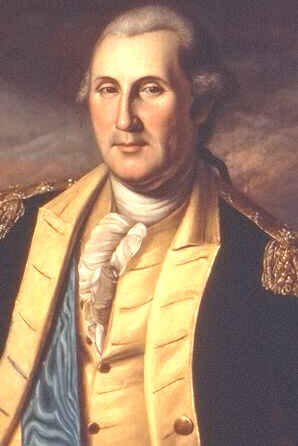 1775
Washington appointed commander of Continental Army
^top^ 1775
Washington appointed commander of Continental Army
^top^
[detail of 1780 portrait by Charles Willson Peale (1741–1827) >]
In Philadelphia, Pennsylvania,
George Washington, a prominent Virginia planter and veteran
of the French and Indian War, is named the first commander-in-chief
of the Continental Army by a unanimous vote of the 2nd Continental
Congress. General Washington, who asked for reimbursement of
future expenses but no payment for his services, would assume
the command on 03 July.
George Washington was born in
1732 to a farm family in Westmoreland County, Virginia, and
through his extensive reading was essentially self-educated.
His first direct military experience came as a major in the
Virginia colonial militia in 1754, when he led a small expedition
against the French in the Ohio River valley on behalf of the
governor of Virginia. Two years later, as a colonel during the
French and Indian War between Britain and France, Washington
took command of the defenses of the western Virginian frontier.
After the war, he resigned from
his military post, and over the next two decades, openly opposed
the escalating British taxation and repression of the American
colonies. In 1774, Washington represented Virginia at the Continental
Congress and, after the American War for Independence erupted
in 1775, was appointed commander-in-chief of the newly established
Continental Army. With this inexperienced and poorly equipped
army of civilian soldiers, Washington led an effective war of
harassment against British forces in America, while employing
his extraordinary diplomatic skills to encourage the intervention
of the French into the conflict on behalf of the colonists.
On 19 October 1781, when British
General Charles Lord Cornwallis surrendered his massive British
army at Yorktown, Virginia, General Washington had defeated
one of the most powerful nations on earth. After the war, the
victorious general retired to his estate at Mount Vernon, but
in 1787 he heeded his nation’s call and returned to politics
to preside over the Constitutional Convention in Philadelphia,
Pennsylvania.
On 30 April 1789, after being
unanimously elected, Washington was inaugurated as the first
president of the United States, and in 1792, was elected to
a second term. While in office, he sought to unite the nation
and protect the interests of the new republic at home and abroad.
In 1797, Washington retired to Mount Vernon, where he died of
natural causes two years later. |
1664 NJ established
1567 Jews are expelled from Genoa Italy
1520 Martin
Luther menacé d'excommunion.
^top^
Condamnation par le Pape Léon
X, au moyen de la Bulle "Exsurge Domine", de Martin Luther
et de son hérésie le Protestantisme. La légende est peut-être
plus vraie que l’histoire ! Elle représente Léon X, pape Médicis
de la beauté, arrêtant à peine une chasse à courre pour signer,
dans une clairière des monts Albins, peu loins de Rome, la condamnation
d’un moine déviant inconnu qui perturbe l’Allemagne. Cette bulle,
publiée à Rome le 15 juin 1520, a été préparée au cours de l’hiver
précédent par une commission de théologiens, issus en majorité
des ordres mendiants prédicateurs officiels des indulgences
et des aumônes pour la basilique Saint-Pierre. Cette vente des
indulgences que justement Luther attaquait ouvertement.
Certains théologiens tentaient
de nuancer la rédaction, alors que le théologien Jean Eck prônait
une condamnation globale et radicale d’un Luther scandaleux
et hérétique. Discutée par quatre consistoires de cardinaux
de curie, la bulle ménage la personne de Luther — il a soixante
jours pour se soumettre — et porte condamnation de quarante
et une propositions doctrinales, tirées des œuvres de l’augustin
saxon. Inspiré du jugement de la faculté théologique de Louvain
du 07 novembre 1519, ce "syllabus", où Jean Eck a fait tout
de même passer six articles condamnant Luther comme défenseur
hérétique des conciles au détriment de la primauté romaine,
constitue le premier condensé de la pensée luthérienne.
Telle quelle, dans le climat
d’une année marquée par la mort de Maximilien Ier et l’élection
difficile de Charles Quint (28 juin 1519), la bulle, instrument
juridique, ne peut constituer un moyen efficace de paix. Luther,
une première fois, en appelle au concile et au pape mal informé.
Le pape étant mieux "informé", il lance un deuxième appel. La
réponse romaine vient alors sous la forme d’une nouvelle bulle
excommuniant cette fois Luther et ses partisans (Decet romanum
pontificem , 03 janvier 1521). Cette bulle ne sera que peu
appliquée en Allemagne.
Sur le terrain de l’Empire, la
publication de la bulle Exsurge Domine ne se fait qu’en
Rhénanie et aux Pays-Bas, parce que Charles Quint y appuie le
nonce Alexandre. Jean Eck, passionnément anti-luthérien, réussit
à en faire des proclamations officielles dans les cathédrales
de Brandenburg, Merseburg, Meissen, dont dépend Wittenberg.
Mais l’exécution des sanctions prises rencontre une résistance
passive ou active quasi générale en terre allemande. Luther
a-t-il jeté au feu un exemplaire de la bulle sous les acclamations
des étudiants de Wittenberg (10 decembre 1520)? En tout cas,
elle a été souvent jetée à l’eau et piétinée ; on a peu brûlé
les écrits de Luther, et le bannissement par Charles Quint hors
de l’Empire du réformateur excommunié n’a jamais été effectif,
protégé qu’il était par Frédéric le Sage de Saxe, bien d’autres
princes, d’autres laïcs et par le peuple.
Nombre d’évêques allemands même
adoptent une attitude "proche du sabotage" (H. Jedin). Cette
résistance s’explique par le fait que Rome a mis les évêques
hors d’affaire dans une procédure judiciaire qui relève en première
instance de leur ressort. Parce que pareille attitude ne donne
pas droit aux justes thèses conciliaristes traditionnelles.
Parce que la Rome papale de la Renaissance ne se remet pas en
cause sous les appels réformistes de Martin Luther, continuant
notamment à prélever de lourdes taxes sur l’Église allemande.
Parce que l’opinion publique persiste à voir en Luther un fils
de l’Église exerçant la liberté chrétienne, résistant mais non
hérétique, dont surtout l’Appel à la noblesse allemande
de l’été 1520 constitue un véritable programme de concile de
réformation. |
1520 Leo X issued the papal encyclical 'Exsurge Domine,' which
condemned German Reformer Martin Luther as a heretic on 41 counts and
branded him an enemy of the Roman Catholic Church.
1502 Descubrimiento de la isla Dominica por Colón durante su cuarto
y último viaje a América. (Véase Viajes
Colombinos).
1389 Battle of Kossovo; Turks defeat Serbs, Bosnians
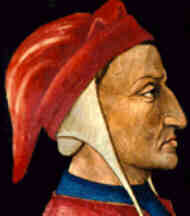 1300
Dante named to city government of Florence
^top^ 1300
Dante named to city government of Florence
^top^
Poet Dante Alighieri,
35, becomes one of six priors of Florence, active in
governing the city. Dante's political activities, which
include the banishment of several rivals, lead to his
own exile from Florence, his native city, after 1302.
He will write his great work, The
Divine Comedy, as a virtual wanderer,
seeking protection for his family in town after town.
Dante was born on 27
May 1265 to a family with noble ancestry whose fortunes
had fallen. His father was a moneylender. Dante began
writing poetry in his teens and received encouragement
from established poets, to whom he sent sonnets as
a young man. At age nine, Dante first caught a glimpse
of Beatrice Portinari, also nine, who would symbolize
for him perfect female beauty and spiritual goodness
in the coming decades. Despite his fervent devotion
to Portinari, who did not seem to return his feelings,
Dante became engaged to Gemma Donati in 1277, but the
two did not marry until eight years later. The couple
had six sons and a daughter.
About 1293, Dante published
a book of prose and poetry called The New Life,
followed a few years later by another collection, The
Banquet. It wasn't until his banishment that he
began work on his Divine Comedy. In the poem's
first book, Dante takes a tour through Hell with the
poet Virgil as his guide. Virgil also guides the poet
through Purgatory in the second book. The poet's guide
in Paradise, however, is named Beatrice. The work was
written and published in sections between 1308 and
1321. Although Dante called the work simply Comedy,
the work became enormously popular, and a deluxe version
published in 1555 in Venice bore the title The Divine
Comedy. Dante died of malaria in Ravenna on 14
September 1321. "Lasciate ogne speranza, voi
ch'intrate". |
[click
on either image for portraits of Dante] |
 La
Divina Commedia
La
Divina Commedia
Poema da Dante Alighieri in terza
rima, iniziato nel 1307, composto di tre Cantiche (Inferno,
Purgatorio, Paradiso) che comprendono 100 canti complessivi:
34 l'"Inferno", 33 ciascuno il "Purgatorio" e il "Paradiso".
Argomento dell'opera è il viaggio compiuto da Dante nell'Oltretomba.
Tre guide conducono il poeta: Virgilio nell'Inferno, e parte
del Purgatorio, fino all'Eden; Beatrice, la donna amata da Dante
in gioventù e il cui ricordo lo ha distolto dal traviamento,
conduce il poeta fino all'Empireo, alla Rosa celeste; e San
Bernardo che mostra a Dante la gloria di Dio. Il viaggio dura
circa una settimana e ha inizio nella notte del Venerdì Santo,
l'8 aprile 1300.
Dante Alighieri nasce nel 1265
da una famiglia guelfa di Firenze, di piccola nobiltà. Amico
di Guido Cavalcanti, di cui inizialmente subì l'egemonia culturale,
partecipò con lui e con altri poeti al movimento del Dolce Stil
Nuovo. Gran parte delle sue rime giovanili sono dedicate ad
una "Beatrice", che viene tradizionalmente identificata con
l'omonima figlia di Folco Portinari, sposata a Simone de' Bardi,
e morta di parto l'8 giugno 1290. Il poeta tra il 1293 e il
1294 rielabora la storia spirituale del suo amore nella "Vita
Nuova", un libriccino mescolato di versi e di prosa.
Dopo questa data Dante comincia
a partecipare alla vita politica di Firenze, del cui esercito
ha fatto parte in diverse occasioni (nel giugno 1289 lo troviamo
tra i "feditori" a cavallo nella battaglia di Campaldino contro
i ghibellini di Arezzo, nell'agosto dello stesso anno è nell'esercito
fiorentino che tolse ai pisani la fortezza di Caprona). Dante,
che aveva trascorso un periodo di studi a Bologna, si iscrisse
alla corporazione dei medici e degli speziali per iniziare la
carriera politica (gli Ordinamenti di Giustizia di Giano della
Bella riservavano il governo del comune solo ai cittadini iscritti
a una delle corporazioni d'arti e mestieri).
Nel 1300 le sue responsabilità
politiche aumentarono, e Dante divenne uno dei Priori, dedicando
la maggior parte delle sue energie a contrastare i piani del
papa Bonifacio VIII. Questi infatti , approfittando del conflitto
presente in Firenze fra i Bianchi, capeggiati dalla consorteria
dei Cerchi, e i Neri guidati da quella dei Donati, cercava di
di estendere la sua autorità su tutta la Toscana.
Nell'ottobre del 1301 il papa
inviò a Firenze Carlo di Valois, fratello del re di Francia,
apparentemente come paciere: ma in realtà Carlo aveva l'incarico
di debellare i Bianchi. Mentre Dante si trovava a Roma come
ambasciatore del comune di Firenze presso il Pontefice, Corso
Donati e i neri conquistarono, con uccisioni e violenze, il
potere.
Dante fu condannato all'interdizione
perpetua dai pubblici uffici, a una multa e all'esilio per due
anni, per furto del denaro pubblico, azioni ostili verso il
papa e la città (non essendosi presentato a discolparsi fu condannato
ad essere bruciato vivo se fosse caduto in mano al Comune).
Dal 1302 comincia il periodo dell'esilio, che durerà fino alla
morte del poeta. Iniziò un pellegrinaggio per l'Italia. Prese
contatto con Bartolomeo della Scala a Verona e con i conti Malaspina
in Lunigiana, e tra il 1304 e il 1307 compose il Convivio
(poi rimasto interrotto) per acquisire meriti di fronte all'opinione
pubblica (per lungo tempo coltivò l'illusione di poter essere
richiamato nella sua città come riconoscimento della sua grandezza
culturale). Appartiene allo stesso periodo il De
Vulgari Eloquentia.
Col passare degli anni Dante
iniziò a vedere il suo esilio come simbolo del distacco dalla
corruzione, dagli odi e dagli egoismi di parte, e si considerò
guida per gli uomini alla riconquista di essa, della verità
e della pace. Tale vocazione ispira la Divina Commedia,
cominciata probabilmente dopo il 1307. Nel 1310 il nuovo imperatore
Arrigo VII scese in Italia e Dante, scrisse delle lettere per
esortare tutti ad accogliere colui che poteva riportare alla
pace; scrisse inoltre il suo trattato politico più importante,
la Monarchia. Ma nel 1313 Arrigo morì improvvisamente
a Buonconvento presso Siena, e Dante abbandonò ogni speranza
di tornare a Firenze. Negli ultimi anni, fu ospite di Can Grande
della Scala a Verona e di Guido Novello da Polenta a Ravenna.
Qui portò a termine l'ultima parte della Commedia, di
cui era già stata pubblicata prima del 1315 la prima cantica,
l'Inferno. Lo scrittore muore a Ravenna nella notte di
13 a 14 settembre 1321. |
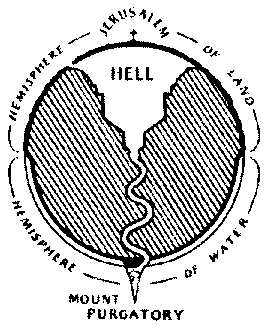
Dante Alighieri's La Divina Commedia
is the allegorical story of spiritual journey, one which began
on Good Friday, 8 April 1300 — when Dante was 35 and thus
midway through his allotted span — and lasted for just
seven days; but it is also a bitter political polemic, excoriating
those in authority in Italy, and above all in his native Florence,
and denouncing the papacy for its wealth and corruption. It
embraces the celestial and the terrestrial, the mythological
and the historical, the practical and the ethical; it discusses
reason and faith, of society and the individual; finally,
it claims to speak with the voice of God.
The earth, we must understand,
is the centre of the universe, of which only the northern hemisphere
is inhabited. Within this hemisphere is hell, a vast funnel
formed by the fall of Lucifer. The earth displaced by the fall
descended to the southern hemisphere where it formed the mountain
of purgatory, rising from the ocean.
This too is conical, with seven
ledges rising to its summit, paradise. Around the earth are
nine concentric revolving heavens , encircling which is the
empyrean, home to the nine orders or angels and the seat of
God. Dante's journey therefore takes him through the entire
universe. It begins in the dark wood of sin where he finds the
poet Virgil, who undertakes to guide him. Down they go through
the deepening circles, speaking with the damned, who are being
punished according to their sins on earth.
Some are mythological, some historical,
some contemporary Florentines. Emerging in the southern hemisphere,
Dante and Virgil sail to purgatory, on whose successive ledges
they find those guilty of the seven deadly sins. They too suffer
horribly but, unlike the denizens of Hell, they have hope; they
are working up towards paradise. There the pagan Virgil must
take his leave , while Dante finds his long-last Beatrice, through
whom he is led to his final vision of God.
Dante was not the first poet
to write in Italian; but he, more than anyone, made his native
Tuscan dialect the literary language of the whole peninsula.
His limpid Italian might have been written yesterday. The work
is not easy, but for anyone prepared to make the effort, the
rewards are great.
The
Divine Comedy is a poem which describes the journey
of Dante the Pilgrim as he is lead, firstly by Virgil through
Hell and Purgatory and secondly by Beatrice through to Heaven.
The poem is therefore separated into three volumes. Each volume
(Inferno, Purgatory and Paradise) is of 33 cantos, except for
Inferno which contains one extra introductory canto which serves
as an overview to what will come.
The interpretation of The Divine
Comedy is much more than a simple poem. In fact Dante even
tells us so in a letter he wrote. Dante says that in the literal
sense his work is a description of 'the state of souls after
death' but if his work is to be taken allegorically then the
subject is ' Man-as, according to his merits or demerits in
the exercise of his free will, he is subject to reward or punishment
by Justice...'. The work therefore investigates Mankind's search
for salvation where man must first descend into humility before
he can raise himself to God. Before man can hope to climb the
mountain of salvation he must first know what sin is. This is
exactly what the Pilgrims journey represents as his pilgrimage
takes Dante (who represents all Mankind) through all the types
of sin in preparation for his ascent to God. |
|
ART ABOUT DANTE ONLINE: [for maximum screen area in Windows:
press F11]
Salvador Dali's illustrations for The Divine Comedy:
http://narthex.com/gallerya.htm
A
page from a Divina Commedia codex — La
barque de Dante — Dante
drinking the waters of the Lethe —
Beatrice Meeting Dante at a Marriage Feast, Denies Him Her
Salutation — Dante's
dream at the death of Beatrice —
The First Anniversary of the Death of Beatrice: Dante Drawing
the Angel — Beatrice
addressing Dante from the whirl —
|
| DANTE ONLINE: |
ENGLISH THE
DIVINE COMEDY
THE
DIVINE COMEDY - HELL
THE
DIVINE COMEDY - PARADISE
THE
DIVINE COMEDY - PURGATORY
The
Divine Comedy
The
Divine Comedy
The Divine Comedy
Hell
— Purgatory
— Paradise
Hell
— Purgatory
— Paradise
The Vision: or, Hell, Purgatory, and Paradise
|
The
Divine Comedy (in Italian and English)
ITALIANO CONVIVIO
LA
DIVINA COMMEDIA
LA
VITA NUOVA
RIME
LATIN VULGARI
ELOQUENTIA
CZECH BOZSKÁ
KOMEDIE
PO-RUSSKI BOZHESTVIENNAYA
KOMEDIYA
MAGYAR VERSEK
DIVINA
COMMEDIA (STENI SZÍNJÁTÉK)
|
1219 King Valdemar brought victory for Denmark
1215
King John accepts Magna
Charta at Runnymede, England
MAGNA CARTA SEALED: Following
a revolt by the English nobility against his rule, King John
puts his royal seal on the Magna Carta, or "Great Charter."
The document, essentially a peace treaty between John and his
barons, guaranteed that the king would respect feudal rights
and privileges, uphold the freedom of the church, and maintain
the nation's laws. Although more a reactionary than a progressive
document in its day, the Magna Carta was seen as a cornerstone
in the development of democratic England by later generations.
John was enthroned as king of
England following the death of his brother, King Richard the
Lion-Hearted, in 1199. King John's reign was characterized by
failure. He lost the duchy of Normandy to the French king and
taxed the English nobility heavily to pay for his foreign misadventures.
He quarreled with Pope Innocent III and sold church offices
to build up the depleted royal coffers. Following the defeat
of a campaign to regain Normandy in 1214, Stephen Langton, the
archbishop of Canterbury, called on the disgruntled barons to
demand a charter of liberties from the king.
In 1215, the barons rose up in
rebellion against the king's abuse of feudal law and custom.
John, faced with a superior force, had no choice but to give
in to their demands. Earlier kings of England had granted concessions
to their feudal barons, but these charters were vaguely worded
and issued voluntarily. The document drawn up for John in June
1215, however, forced the king to make specific guarantees of
the rights and privileges of his barons and the freedom of the
church. On June 15, 1215, John met the barons at Runnymede on
the Thames and set his seal to the Articles of the Barons, which
after minor revision was formally issued as the Magna Carta.
The charter consisted of a preamble
and 63 clauses and dealt mainly with feudal concerns that had
little impact outside 13th century England. However, the document
was remarkable in that it implied there were laws the king was
bound to observe, thus precluding any future claim to absolutism
by the English monarch. Of greatest interest to later generations
was clause 39, which stated that "no free man shall be arrested
or imprisoned or disseised [dispossessed] or outlawed or exiled
or in any way victimised...except by the lawful judgment of
his peers or by the law of the land." This clause has been celebrated
as an early guarantee of trial by jury and of habeas corpus
and inspired England's Petition of Right (1628) and the Habeas
Corpus Act (1679).
In immediate terms, the Magna
Carta was a failure--civil war broke out the same year, and
John ignored his obligations under the charter. Upon his death
in 1216, however, the Magna Carta was reissued with some changes
by his son, King Henry III, and then reissued again in 1217.
That year, the rebellious barons were defeated by the king's
forces. In 1225, Henry III voluntarily reissued the Magna Carta
a third time, and it formally entered English statute law.
The Magna Carta has been subject
to a great deal of historical exaggeration; it did not establish
Parliament, as some have claimed, nor more than vaguely allude
to the liberal democratic ideals of later centuries. However,
as a symbol of the sovereignty of the rule of law, it was of
fundamental importance to the constitutional development of
England. Four original copies of the Magna Carta of 1215 exist
today: one in Lincoln Cathedral, one in Salisbury Cathedral,
and two in the British Museum.
Dans une prairie des environs
de Windsor, les barons anglais imposent au roi Jean sans Terre
la signature d'un traité connu sous le nom de «Grande Charte».
Violent et sans scrupules, le plus jeune fils d'Aliénor d'Aquitaine
et d'Henri II Plantagenêt a réussi dès le début de son règne
à se faire haïr de la noblesse comme des bourgeois, du clergé
et des paysans. On le soupçonne d'avoir tué son neveu Arthur
pour s'approprier le trône à la mort de son frère Richard Coeur
de Lion. Par ses maladresses, Jean sans Terre a perdu la plupart
des seigneuries que possédait sa famille en France. Le roi de
France Philippe Auguste écrase ses alliés à Bouvines et se prépare
à envahir l'Angleterre en vue de le chasser du trône.
Humilié, Jean sans Terre n'a
d'autre issue que de se soumettre aux exigences de ses barons
pour conserver leur soutien. C'est ainsi qu'en signant la Grande
Charte, il s'engage à ne pas lever d'impôts sans demander l'accord
d'un Grand conseil composé de barons et d'ecclésiastiques et
à ne pas procéder à des arrestations arbitraires. Vingt-cinq
barons, y compris le Maire de Londres, doivent surveiller le
respect de ces clauses. Avec la Grande Charte, la noblesse anglaise
impose au roi le respect de ses droits féodaux. Mais la postérité
verra dans ce texte en 63 articles la première limitation imposée
à l'arbitraire monarchique et l'amorce de la démocratie moderne.
La Grande Charte est encore de nos jours à la base des institutions
britanniques.
La
Grande Charte traduite en français |
--763 -BC- Assyrians record total solar eclipse event on clay
tablet
|
 ^
2002 “No need for Stalin to resign”
^
2002 “No need for Stalin to resign”
 2000
2000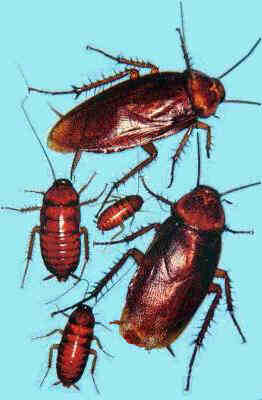
 .
.


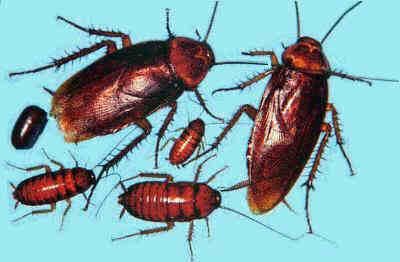
 1775
1775


